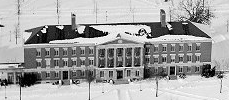
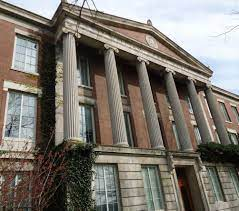
| River Campus | Morey Hall |
 |
 |
| Morey
Hall in the 1930s |
Morey Hall |
| William C. Morey, note that his plaque hanging in Morey Hall shows him being an emeritus professor until 1928. | ||
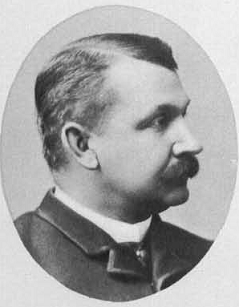 |
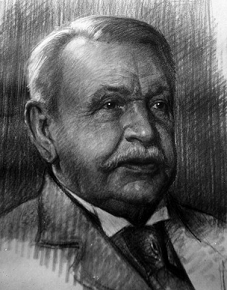 |
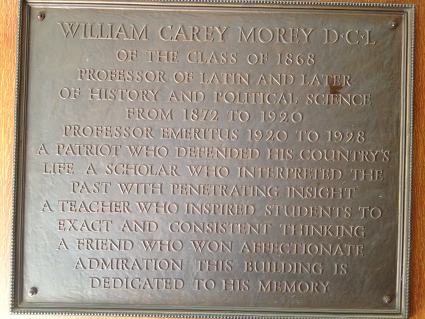 |
Morey Hall opened in October 1930 on the north side of Eastman Quadrangle. It was named for long-time faculty member William C. Morey, who had enrolled as an undergraduate in 1861 but left after his first year to enlist in the Army at the age of 19. He served in several campaigns and was promoted several times, ending the war as a brevet Lieutenant Colonel. He was present when Lee surrendered at Appomattox. After the war he returned to the University and received an A.B. degree in 1868 with an M.A. in 1871. He was appointed professor of Latin Languages and Literature in 1877 and Professor of History and Political Science in 1883. He retired in 1920 and died in 1925. Morey received an honorary Ph.D. from Franklin College in 1881 and an honorary Doctor of Civil Law (D.C.L) from Denison University in 1903.
The building was occupied by administration offices, social studies, languages and literature, and mathematics. Although it had five stories with three facing the quadrangle, the building did not have an elevator until Rettnet Hall was built in 2013, which connected to the west end of Morey. The project included an elevator in Morey that all floors of both buildings.
Morey Hall has never been completely remodeled, although some cosmetic improvements have been made. The original heating apparatus is largely intact.
References
1868 Journal
of the Executive Proceedings of the Senate, Volume 40
Pages 245-247: To be majors by brevet.
William C. Morey, late captain of the Nineteenth New York Cavalry, for
gallant and meritorious services during the war, to date from March 13,
1865.
To be lieutenant-colonels by brevet.
Brevet Major William C. Morey, late captain of the Nineteenth New York
Cavalry, for gallant and meritorious services during the war, to date from
March 13, 1865.
Andrew Johnson, May 12, 1868
1880 History
of Kalamazoo County, Michigan, by Samuel W. Durant
Page 149: The Kalamazoo Theological College.
William C. Morey, A.M., became an instructor on the resignation of Dr.
Wayland, and soon after was seleced Professor of History and Political
Economy. He resigned this chair in 1872, to accept a professorship
in the University of Rochester, where he remains till now. On his
retirement, Rev. William T. Stott was made Professor of Natural Sciences,
but after accepting the appointment, and having served the college one
term, he was called to the presidency of Franklin College, and
resigned. He still remains president of the college which has twice
deprived Kalamazoo of an able teacher to fill that office.
1883 "Herbert Spencer in the Light of History," by William C. Morey, The Baptist Quarterly Review 5(19):279-309 (1883)
1884 Outlines of Roman Law: Comprising Its Historical Growth and General Principles, by William Carey Morey
1886 An
Outline History of the University of Rochester
Page 25: 1869. Colonel William C. Morey (Class of '68) was appointed Tutor
in Latin.
Page 26: 1872. Colonel William C. Morey (1868) succeeded the Rev. A.J.
Sage as Professor the Latin Language and Literature.
Page 30: 1883. William C. Morey became Professor of History and Political
Science.
1891 "The genesis of a written constitution," by William C Morey, Reprinted from the Annals of the American Academy of Political and Social Science, April 1891.
1895 Papers and Addresses of Martin B. Anderson, LL. D., Volume 1, edited by William C. Morey | Volume 2 |
1900 General
Catalogue of the University of Rochester, 1850-1900
Pages 74-75: William Carey Morey, A.B.; A.M., 1871, Ph. D., Franklin
college, 1881. A. Δ. Φ.; Φ. B. K. Received 1st Sophomore declamation
prize; 1st Davis prize medal. Prepared at Wyoming, N. Y.; enlisted 130th
N. Y. infantry, 1862; regiment changed to 1st N. Y. dragoons (19th N. Y.
cavalry), 1863; second lieutenant, 1863; first lieutenant, 1864; captain,
1864; brevet major and lieutenant colonel, 1865; served under Gen.
Sheridan in Wilderness campaign, Richmond raid, Trevillian raid,
Shenandoah valley campaign, James river raid, last Petersburg campaign,
present at Lee's surrender at Appomatox Court House; student Rochester
theological seminary, 1868–1869; tutor University of Rochester, 1869–1870;
professor of history and English literature, Kalamazoo college, Mich.,
1870-1872; professor of Latin language and literature, University of
Rochester, 1872-1877; professor of Latin and history, 1877–1883; professor
of history and political science, 1883–. Member of American social science
association; American historical society; American institute of civics;
American academy of political and social science. Author of Outlines of
Roman law, 1884; Genesis of a written constitution, 1891; First State
constitutions, 1892; Sources of American federalism, 1895; Papers and
addresses of Martin B. Anderson, LL. D., 1895; Outlines of Roman history,
1900; contributions to Baptist quarterly review, and other journals.
Address, 94 Oxford St., Rochester, N. Y.
1900 Regimental
History of the First New York Dragoons: (originally the 130th 130th
N.Y. Vol. Infantry) During Three Years of Active Service in the Great
Civil War by James Riley Bowen
Page 317-323: List of engagements in which the First New York
Dragoons (originally the One Hundred Thirtieth Infantry) participated, by
William C. Morey, Captain Co. D, First New York Dragoons, Brevet
Lieutenant-Colonel, United States Volunteers.
1901 Outlines of Roman History: To the Revival of the Empire of Charlemagne, by William Carey Morey
1902 The Government of New York: Its History and Administration, by William Carey Morey
1907 Memorial
Volume of Denison University, 1831-1906
Pages 197-198: Honorary Degrees Granted by Denison University
Doctor of Civil Law, Prof. W. C. Morey, 1903
1903 Address of Prof. William C. Morey, D.C.L., to the Rochester Bar Association on "International Right of Way", December 8, 1903, by William Carey Morey
1906 Outlines of Ancient History: For the Use of High Schools and Academies, by William Carey Morey
1908 Outlines of Greek History: With a Survey of Ancient Oriental Nations, by William Carey Morey
1909 The treaty-making power and the legislative authority of the states, by William C. Morey
1910 American education and American citizenship; an address delivered before the Associated alumni of the University of Rochester, by William Carey Morey, June 13, 1910
1910 Rochester
Theological Seminary General Catalogue 1850 to 1910
Pages 68-69: William Carey Morey, b. Attleboro, Mass., May 23, 1843;
2nd lieut. 19th N. Y. Cav., 1863–64; 1st lieut. and capt., 1st N. Y.
Dragoons, 1864-65; brevet major and brevet lieut. col. U. S. Vols., 1865;
U. R. 1868; R. T. S. 1868-69; tutor in Latin, U. R. 1869–70; prof. History
and English Lit., Kal. C., 1870-72; prof. Latin Lang. and Lit., U. R.,
1872–77; Latin and History, ib., 1877-83; History and Political Science,
ib., 1883–. Author, Outlines of Roman Law; editor of Papers
and Addresses of Martin B. Anderson, LL. D.; Genesis of a
Written Constitution; First State Constitutions; Sources
of American Federalism; Rome and the Provinces; Outlines
of Roman History; Government of New York; Outlines of
Greek History; Outlines of Ancient History. Ph.D., F. C.,
1881; D.C.L., D. U., 1903 and U. R., 1908. Address, 94 Oxford St.,
Rochester, N. Y.
1911 The Study of Roman Law in Liberal Education, by William C. Morey
1912 New
York in the War of the Rebellion, 1861 to 1865
Page 1147-1150: First Regiment of Dragoons. Company D.
Second Lieutenants: William C. Morey, from August 1, 1863 to January
18, 1864.
First Lieutenants: William C. Morey, from January 18 to December 24,
1864.
Captains: William C. Morey, from December 24 to June 30, 1865.
Page 1158: Morey, William C. age 19 years; enrolled August 16, 1862,
at Wyoming to serve three years; mustered in as Private, Company D, 130th
Infantry, August 19, 1862; promoted Sergeant, September 3, 1862; mustered
in as Second Lieutenant, August 1, 1863; as First Lieutenant, January 18,
1864; as Captain, December 24, 1864; mustered out with company, June 30,
1865, at Cloud's Mills, Va.; Lieutenant-Colonel, U. S. Volunteers, by
brevet, March 13, 1865; commissioned Second Lieutenant, August 21, 1863,
with rank from August 1, 1863, vice J. M. Bills, promoted; First
Lieutenant, February 17, 1864, with rank from January 18, 1864, vice J. M.
Bills, resigned; Captain, January 31, 1865, with rank from December 10,
1864, vice Knapp promoted.
1915 Ancient Peoples: A Revision of Morey's "Outlines of Ancient History", by William Carey Morey
1920 Doctor
William Carey Morey, University of Rochester, Alumni Federation.
A hand lettered and illuminated tribute presented to Doctor Morey with a
purse of gold at the time of his retirement in 1920.
1925 "William
C. Morey Dies; Former Professor of History in the University of
Rochester Was 81," The New York Times, January 21, 1925,
Page 21.
Former Professor of History in the University of Rochester was 81.
Rochester, Jan. 21. - Professor William Carey Morey, Ph.D., D.C.L., from
1883 to 1920 Professor of History and Political Science in the University
of Rochester and head of the University's departments of history and
political science, died at his home in this city shortly after
midnight. He left a widow, Margaret Parkhurst Morey. Funeral
services will take place in this city with burial at Coldwater, Mich.
1925 Col
William Carey Morey (1843-1925) grave, Oak Grove Cemetery,
Coldwater, Branch County Michigan
In 1862 he entered the University of Rochester, but left shortly afterward
to join the Union Army. At the end of the Civil War, he retired from the
army as brevet major and lieutenant colonel of the cavalry. He then
re-entered the University of Rochester, graduating in 1868. He was a
student at Rochester Theological Seminary for one Year and a tutor at the
University of Rochester before becoming a professor of history and English
literature at Kalamazoo College. In 1872 he returned to the University of
Rochester, teaching Latin language and literature until 1877. From 1877 to
1883 he was professor of Latin and history, and from 1883 until his
retirement in 1920, he taught history and political science.
1925 "$18,000
Estate Left by Dr. W.C. Morey, U. of R. Professor," Democrat and
Chronicle, August 1, 1925, Page 15.
Dr. William C. Morey, former professor emeritus of history at the
University of Rochester, left a net estate of $18,517.46, according to a
transfer tax deposition filed yesterday.
Since Morey's Death last February, royalties on five books of classical
history have added $1,086.98 to the estate. According t the report
filed in Surrogate's Course by the Security Trust Company, executor of his
estate. Professor Morey's "Ancient Peoples" is the most popular of
his books, drawing $616.72 in royalties since he died. Other
receipts were "Roman Law," $18.02; "Outlines of Ancient History," $161.57;
"Outline of Greek and Roman History," $20.48; Outlines of Roman History,"
$101.11; and "Outlines of Greek History," $169.05.
1950 The
University of Rochester: The First Hundred Years | pdf
|
Page 18: Nevertheless, Professor Morey went right on teaching
history, government, and Roman law in masterly fashion. Though some
thought him dogmatic, one of his students wrote:
"I would especially mention Dr. William C. Morey, 'Uncle Bill,' as he was
affectionately called, as the man who taught me to look on all sides of
every question, to recognize that all sides have some truth, and that the
highest truth lies between the extremes."
Morey Hall might therefore be said to be overcrowded with "all the sides
of truth," and should be enlarged before it bursts.
1977 History
of the University of Rochester, 1850-1962, by Arthur J.
May. Expanded edition with notes
Chapter 7, The Civil War
On Sunday, April 9, 1865, General Robert E. Lee surrendered at Appomattox
Court House, and among those present was a young man destined to write his
name large in Rochester annals--William Carey Morey. "...The cavalry were
forming for a charge," he set down in his diary, "when a flag of truce
came to our lines from Gen. Lee.... The firing ceased and was succeeded by
the most enthusiastic cheering.... When the result was known to be
'unconditional surrender,' went... to the house where the conference [with
General Ulysses S. Grant] was held; saw Gen. Lee as he left the house,
mount his horse and ride back to his dilapidated army."
Chapter 9: University Gallery
Why should the building on the River Campus in which the humanities and
the social studies are taught be known by the name of Morey, it has often
been asked by students and visitors to the University. Like its
counterparts, Dewey and Lattimore Halls, fronting on the Eastman
Quadrangle, Morey Hall is a constant reminder of an immortal in the U. of
R. saga. By way of explanation, a memorial marker at the Morey Hall
entrance speaks of William Carey Morey as a patriot who defended his
country's life, a scholar who interpreted the past with penetrating
insight, a teacher who inspired students to exact and consistent thinking,
[and] a friend who won affectionate admiration..."
After his first year as a student at the college, Morey enlisted in the
Union Army. And throughout the Civil War, merging as a brevet
lieutenant-colonel. Resuming his studies, he graduated in the class of
1868. Except for a short teaching experience elsewhere, his life was bound
up with the U. of R. until he died in 1925, five years after he had laid
down classroom duties. Invitations to cast in his fortunes with other
institutions, such as Northwestern University, Yale, and the Minneapolis
Library, Morey turned aside. If his accomplishments in productive
scholarship are less impressive than Fairchild's, the impact of "Uncle
Bill" upon the undergraduate body and the Rochester community was more
general and deeper.
A student admirer, spokesman for hundreds, testified to the extra ordinary
effectiveness of Morey in language that any dedicated college teacher
might covet. He "... taught me to look on all sides of every question, to
recognize that all sides have some truth, and that the highest truth lies
between the extremes." True enough, the Interpres of 1876 alluded
to Morey as "...conceited, foppish, as self-willed as a mule... sensitive
to the very core," but if that appraisal was anything other than sardonic
satire, it soon yielded to a radically different estimate.
Upon his retirement, the alumni of the college presented Morey with a
purse of gold and an illuminated parchment which read in part, "Dear Uncle
Bill: For fifty years you have faithfully served the U. of R. and by our
scholarly attainments and your widely extended reputation have contributed
to its ever-growing strength and standing. But more significant still is
what you have done for us, the boys who come under your influence... we
learned to love you, Uncle Bill--our teacher and our friend... "
Starting his teaching career as an instructor of Latin, Morey insisted
that the students should learn by heart the Odes of Horace, and he quoted
aphorisms of the Roman poet on every suitable occasion. More interested in
subject matter than in the literary style of Roman men of letters, he
stressed the historical and legal aspects of the ancient Empire. For
instructional purposes, he prescribed the celebrated Institutes of
Justinian, which led him easily and naturally into scholarly
investigations of Roman law, on which he made himself an authority. He
organized a course on Roman law--one of the first in the United
States--noted for clarity and appeal, and in the process he developed a
far greater concern for history than for Latin literature. To stimulate
student interest, he converted the class into a Roman courtroom with
counsel, witnesses, cross-examination, and so forth. President Anderson,
who firmly believed in the values of the historical approach to any area
of knowledge, recommended (1871) to the trustees that a new professorship
in history and political science be instituted. University catalogues, it
is true, listed courses in history, economics, and international law, but,
if taught at all, these disciplines were sidelines of teachers in other
departments of learning or of the chief executive himself. Anderson
groomed Morey for a special chair in social studies, and Morey groomed
himself.
In 1877 a semi-independent department, attached to the offerings in Latin,
presented courses in medieval history, the history of civilization
(formerly Anderson's sphere), and in Roman law, and shortly thereafter
Morey introduced instruction in the American and English constitutions. So
the way was prepared for a separate department of history and political
science created in 1883. Study of the constitutional and political history
of the United States was initiated four years later; and a "seminary in
American history" was presently announced, reinforced by an
extracurricular historical club for Seniors. More than previously, Morey
conducted his courses in such a way as to impress undergraduates with the
obligations of citizenship and to encourage positive participation in the
great world of public affairs. To the success of that emphasis, to the
profoundly inspirational quality of his teaching, a cloud of witnesses has
testified. After President Anderson retired, Morey took over instruction
in economics until a new department in that subject was set up.
Apart from contributions to Baptist and secular journals, Morey published
a string of books on his scholarly concerns, notably on Roman law and
history and on constitutional history. Besides, he edited The Papers
and Addresses of Martin B. Anderson, a skillful selection from the
voluminous writings of the "old-time" college President. Drawing upon his
wartime experiences, Morey frequently delivered a famous lecture on "The
Last Campaigns of the Civil War" to meetings of army veterans and other
organizations.
His flair for working harmoniously with kindred spirits was shown during
service as trustee of the Reynolds Library in Rochester; as a director of
that institution he worked energetically to enlarge the resources and
devised an original scheme for classification of the book collections--a
service he also performed for the University library. As another means of
promoting community cultural life, he assisted in founding the Rochester
Historical Society, assumed responsibility for choosing topics to be
investigated by its members and then discussed around a table, more or
less in imitation of his seminar at the college. A good clubman, papers
that he read to the "Pundits" exhibited the versatility of his mind and
intellectual interests.
On the eve of his final withdrawal from the classroom, Morey's colleagues
saluted him for "long and distinguished service to the college, the
community, and the cause of learning." At his death, resolutions by the
faculty stated that, "In the endeavor to apply the principles of human
justice, between men and between nations, to the development of judicial
and legislative codes, it was his task to study the relation of the ideal
to the possible. As scholar and teacher he was judicial, keen, analytical,
thorough, exacting in his intellectual standards. Abhorring loose thinking
and shallow speaking, he trained his students to admire, if not always to
practise, restraint and precision of style."
For the community, the Times-Union obituary asserted, "The
greatest teacher is he who can not only impart knowledge and skillfully
direct study, but can inspire and stimulate his students to think for
themselves.... " That rare ability was possessed by Professor Morey.... He
was an active force in the intellectual life of the city, a citizen of
whom Rochester was justly proud.... "
Chapter 22, Oak Hill Becomes River Campus
Matching these buildings on the opposite side of the Quadrangle, and like
them linked by colonnades, were the Samuel A. Lattimore Hall of chemistry
and William Carey Morey Hall assigned to administration offices, social
studies, languages and literatures, and mathematics. Owing to the sloping
terrain, these two buildings had three stories on the front, but five to
the north. By an incredible oversight, Morey was not fitted out with an
elevator.
Chapter 26, The Depression Decade
For research purposes, the two lower floors on the north side of Morey
Hall were converted into a laboratory of psychology.
2007 An unvarnished tale : the public and private Civil War writings of Porter Farley, 140th N.Y.V.
2014 "Rettner
Fund supports River Campus renovation, preservation," Currents,
April 26, 2014
Beginning this summer, the fund will initiate a multifloor renovation of
Morey Hall, which connects to Ronald Rettner Hall for Media Arts and
Innovation. Most notable is a renovation of the hall’s main lobby and
corridor. Rettner has worked with University architects and designers to
create a warm, open design that includes a new multifunctional space for
events and meetings, and cosmetic updates will add comfort and vibrancy.
He emphasizes that the project will protect the building’s existing
beauty, including preserving its terrazzo flooring and enhancing its
woodwork.
William
Carey Morey papers, Rush Rhees Library Rare Books and Special
Collections
The William Carey Morey Papers include the diary that Professor Morey kept
while in 130th New York Infantry, the 1st New York Dragoons, 1863-65, as
well as published and unpublished writings on English and American
constitutional law, and report on Rochester schools, 1873.
© 2021 Morris A. Pierce